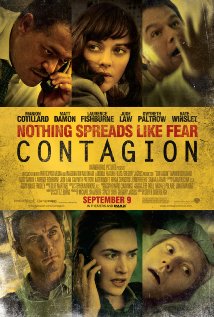 Steven Soderbergh directs a cast full of A-list Hollywood celebrities in the recently released Contagion. Playing into fears that to some extent are natural, while at the same time too often stoked of late by government fearmongers, it tells the story of a new virus that spreads quickly and wreaks havoc on the human race. Some very recognizable faces of the Hollywood elite turn splotchy and froth at the mouth.
Steven Soderbergh directs a cast full of A-list Hollywood celebrities in the recently released Contagion. Playing into fears that to some extent are natural, while at the same time too often stoked of late by government fearmongers, it tells the story of a new virus that spreads quickly and wreaks havoc on the human race. Some very recognizable faces of the Hollywood elite turn splotchy and froth at the mouth.
Comparisons will be made to Wolfgang Petersen’s Outbreak, but beyond the subject matter and big name actors, they do not much resemble one another. Contagion is either a well-researched and realistic movie about the response to a worldwide infectious disease — especially realistic at the level of government agencies like WHO and CDC — a carefully crafted fraud that makes you think it is, or a mix of the two. There are multiple storylines and it feels, at times, like a documentary. Outbreak is more fanciful and less earnest, investing little effort and less concern in realism but a good deal more in story. All things considered, I would say that Outbreak is the superior work, but Contagion is good in every aspect in which — one gets the feeling — it bothered to put in some elbow grease and is worth a viewing at the theater.
Where did it put this elbow grease? In the shots, in the blocking, in the photography, in the acting, in the editing — everywhere but the script. As one would expect from a Soderbergh film, it is well shot. Everything around the story works at a higher level than what you usually find in theaters nowadays. It has a good solid skeleton, healthy skin, strong muscles, even a brain, but it lacks a heart.
Perhaps it is a bit unfair to say that no elbow grease was spent on the script. I do not mean to give the impression that the screenwriter was incompetent. It was, as I said, either a well-researched flick or a good facsimile, either of which takes some work and skill. However, the type of story it tells, and the time it has to tell it, limit how emotionally invested we can become in the characters, which in turn limits how engrossed we can be in the action, the obstacles, and the resolution.
It is not just that there are so many characters that we can spend too little time with them to care about them. It is also that the movie is so concerned about giving us a clinical portrayal of what would likely happen in the event of such a virus, it does not give us the satisfying story and character arcs we demand from a script. In Outbreak, when Dustin Hoffman was up in the helicopter pleading with the other pilots not to drop the bomb, it strayed from realism, but it at least obeyed the story mandate for a climax. One could argue, as I do, that it strayed perhaps a bit too far (it can be tricky to find the right balance to meet story demands and not make your audience roll their eyes), but at least it was a crescendo of action leading to an exciting resolution.
Real life does not maintain a consistent pace to keep audience attention, and neither does its action necessarily rise to the final climax. There is, many times, no final climax. Different story threads don’t always cross and recross and get neatly tied up by the end. While Contagion does a good job of pacing the advance of the disease, it has far too many characters to adequately explore in a period of 105 minutes, and it eschews any type of contrivance or coincidence to up the ante once in a while. Many storylines are abandoned half-finished, and the ones that do wrap up in the traditional fashion usually have not been explored enough, given quite enough obstacles to overcome to be truly satisfying when it is all over.
Spartacus handles a large cast of characters while not skimping on the story arcs, but Spartacus is three hours long, and takes liberties with the actual story. It does not introduce a character whom it is not prepared to see through to the end, and whom it is not prepared to fully flesh out as a human being. Sometimes, whether it is based on a true story or simply trying to be a plausible work of fiction, a less likely path must be pursued in the interest of developing characters and relationships.
For instance, in Outbreak, Dustin Hoffman and Rene Russo are ex-lovers who must work together to fight the disease. While they fight the disease, their relationship evolves and… well, you can guess what happens at the end. It is entirely expected and traditional, but it is a tradition with a long history of success. In Contagion, Matt Damon and Gwyneth Paltrow, as Mitch and Beth Emhoff, also have problems with their relationship. Beth, we find out right away, is cheating on Mitch, but it is not developed or explored. Opportunities for dramatic tension, interaction, and conflict are not realized, because it plays out how it likely would in real life. There is no arc and no resolution, no confrontation with the other man, nothing. This is not to say that the script should have delved into their marital problems more, merely that it might have and come away with something more satisfying. Somewhere, certainly, we needed more of that sort of thing, if not with Damon and Paltrow, then with Fishburne, or Cotillard, or someone.
In short, it is too realistic to be a very memorable tale, too focused on the progression of disease and the response of professionals and not enough on the people we are watching. Too much like a convenience store security video and not enough like a cop show reenactment. When I go to work in real life, I rarely have a dramatic interaction with my coworkers the likes of which would entertain audiences in a movie theater. A story about my life would have to play loose with the facts in the interest of audience interest. Something in between Outbreak’s flouting of genuine experience and Contagion’s dogmatic adherence to it would probably yield a pretty thrilling movie.

Contagion should either have worried about fewer characters or committed to being 150 minutes long and allowed some of its characters to push at the bounds of realism, just a touch. For instance, when Matt Damon’s Mitch Emhoff and his daughter are left without food, more could have been done than merely showing them wandering around and not finding any. A dangerous plot might have been hatched. This dangerous plot might have accidentally interfered with efforts to get the vaccine out. Emhoff might have met someone with important information that needed to get to the proper authorities and he had to decide between his quest for food and helping that person get out of the quarantined zone. All actions that, while not impossible, push at the bounds of what is probable, but not so much as to cause an audience to be incredulous.
Soderbergh would probably counter that this was not the kind of tale he was trying to tell. I believe it, because there is nothing in the movie to suggest that it got out of his control, nor has any other effort of his ever displayed such. But whether or not the movie was what he wanted it to be, it was limited in what it could do for an audience. None of the characters are memorable, and it is not because the actors did not get the job done. There was just not enough story to work with. Soderbergh no doubt hit the mark he was aiming at, but aiming at such a mark is unlikely to produce a classic film.
From the libertarian’s perspective, the movie was not as offensive as it might have been. For the most part, opinions about private vs. public and market vs. government are mouthed by characters who are proved neither right nor wrong. I never got the sense that Soderbergh was giving a lecture about it. The government agents are uniformly portrayed in a positive light, with no ulterior motives or nefarious intent, but what more can we expect? At least in one instance a man working in the private sector disobeys a government order. He complains that letting the government do the job would make it take too long, and he is able to accomplish a very important task because of his disobedience.
The worst aspect, as far as politics goes, is a lost opportunity to give a lesson on supply and demand. A vaccine is developed for the virus, but lots have to be drawn because the vaccine cannot be made rapidly enough to meet demand. Why this was the case is not discussed, but anyone with a passing familiarity with the pharmaceutical industry will suspect price controls and intellectual property right away. There are shortages of vaccines every flu season, it seems. It is disappointing, though not surprising, that this opportunity was missed.
However much I wish it had been different, or could have been improved, it is still better than the average disaster on celluloid you get charged ten dollars to see. It is no great sin to miss it, but if you are headed to the theaters anyway, I cannot think of a better way, at the moment, to lose that ten dollars.














